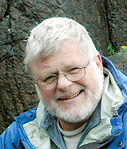Eric Essene
Eric Essene, a highly regarded and widely cited professor emeritus of geological sciences, died of kidney cancer May 20 in Ann Arbor. He was 71.
“Professor Essene made insightful and seminal contributions to understanding the pressure-temperature conditions at which ancient mountain belts formed and constraints on the speed with which rocks are transported to the surface,” says Samuel Mukasa, who is the Eric J. Essene Collegiate Professor and Chair of Geological Sciences. “A number of his peers consider Eric to be the most influential petrologist of his generation.”

Photo by Peter van Keken.
Essene, known to his friends and students simply as Eric, was born in Berkeley, Calif., on April 26, 1939.
Essene received his bachelor of science in geology from the Massachusetts Institute of Technology in 1961 and his doctorate from the University of California, Berkeley, in 1967. He was a National Science Foundation postdoctoral fellow at Cambridge University in 1967-68 and a research fellow at Australian National University, Canberra from 1968-70. He joined U-M as an assistant professor in 1970.
Although Essene was primarily a metamorphic petrologist, he pioneered interdisciplinary research, with interests spanning the fields of mineralogy, geochemistry and general petrology. The basic theme of his research was the application of chemical thermodynamics to the understanding of the Earth’s crust and mantle.
“His research contributed to the development and critical evaluation of thermodynamic methods — geothermobarometers — used to measure temperatures and pressures in ancient mountain belts, and other thermodynamic methods — geospeedometers — used to place constraints on the speed with which rocks are exhumed from great depths by tectonic processes,” Mukasa says. This research led him to fieldwork on four continents. In particular, over a period of 40 years, Essene and his students made seminal contributions to the history of the 1 billion-year-old Grenville Mountain Belt, which is represented today by deeply eroded crystalline rocks from its former root zone that are exposed in the Adirondack Mountains, N.Y., and extending northeast to Labrador.
In terms of total literature citations of his research, Essene numbers among the top 100 geoscientists in the world.
Essene received numerous awards and honors, including the Bowen Medal in 1991 by the American Geophysical Union; the first Sokol Award in 1993 for excellence in graduate education of the sciences from U-M; the William C. Kelly Collegiate Professorship of Geological Sciences in 1997; and the Penrose Medal, the top prize awarded by the Geological Society of America to individuals who significantly advance the study of geosciences, in 2010. He was elected a fellow of the Mineralogical Society of America in 1981, and a fellow of the American Geophysical Union in 1991.
Essene contributed numerous articles, essays and book chapters on a variety of subjects and in countless numbers of scientific publications. Another of Essene’s enduring legacies is his direction and co-direction of more than 100 master’s and doctoral students, many of whom have gone on to stellar careers in the geosciences and are themselves training the next generation of geoscientists.
Essene is survived by his wife, Joyce Budai, and sons Adam Essene and Zachary Essene, all of Ann Arbor; his sister, Karen of Honolulu, Hawaii; former wife, Gail Jones of Sanibel Island, Fla., and daughters Ren Essene of Washington, D.C., and Missoula, Mont., and Dr. Michelle Essene Haroldson of Excelsior, Minn.; and two grandchildren.
Memorial donations may be made to the Eric J. Essene Endowment for Graduate Student Fellowships, c/o Dept. of Geological Sciences, University of Michigan, 2534 C.C. Little Bldg, Ann Arbor, MI 48109-1005 or online at www.lsa.umich.edu/alumni/giveonline.
—Submitted by Nancy Ross-Flanigan, News Service

